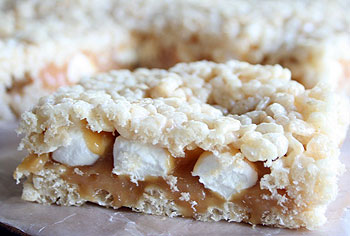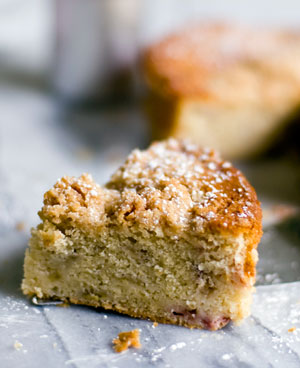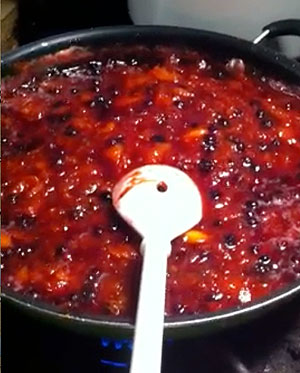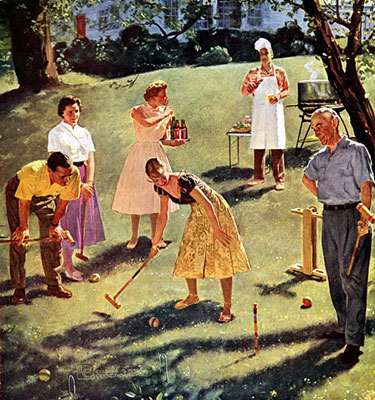 Surprised? I know. I wouldn’t normally post a recipe for sweet bars made with crisp rice cereal and marshmallows. I’m going to a family reunion. There will be lots of kids there — little ones and big ones, too, if you know what I mean. Kids love rice krispie bars. I’m taking a very light, bright and healthful cabbage salad, too. So, it will all balance out in the sugar and calorie department.
Surprised? I know. I wouldn’t normally post a recipe for sweet bars made with crisp rice cereal and marshmallows. I’m going to a family reunion. There will be lots of kids there — little ones and big ones, too, if you know what I mean. Kids love rice krispie bars. I’m taking a very light, bright and healthful cabbage salad, too. So, it will all balance out in the sugar and calorie department.
This recipe came to me from a friend sometime in the early 1980′s. My boys were at a rice krispie bar stage of their lives. That stage coincided with a “not-much-time-to-bake” time in my life.
No-bake Caramel Krispies are made by making two layers of the rice krispie, butter and marshmallow mixture in jelly-roll pans. A filling of caramel, more butter and a can of sweetened condensed milk is heated together and when the caramels are melted, the mixture gets poured over one of the layers that has been sprinkled with more mini-marshmallows.

 It’s rhubarb season. I took me a while but I have discovered rhubarb. And what I have discovered is that I like them. I like them in a crisp, in a buckle, in a muffin, stewed with other fruit, and in a pie. The word rhubarb was a turn off for me. I don’t know why. I just had a visceral aversion to it.
It’s rhubarb season. I took me a while but I have discovered rhubarb. And what I have discovered is that I like them. I like them in a crisp, in a buckle, in a muffin, stewed with other fruit, and in a pie. The word rhubarb was a turn off for me. I don’t know why. I just had a visceral aversion to it. Have you opened your freezer lately? I bet it's completely full just like mine. And how about the pantry? In the freezer I had a package of peas and sliced pancetta leftover from this
Have you opened your freezer lately? I bet it's completely full just like mine. And how about the pantry? In the freezer I had a package of peas and sliced pancetta leftover from this  The day after Easter I always find myself with a huge pot of leftover ham stock. In my family we traditionally eat boiled ham and eggs for the holiday. It's a very simple meal that I look forward to every year. I love hard-boiled eggs, so Easter has always been a favorite time of year, because I get to eat all the foods I love, including chocolate. But what to do with all the leftover ham stock? My mom typically makes ham and bean soup, but in the past few years I've started my own tradition of making ham and split pea soup.
The day after Easter I always find myself with a huge pot of leftover ham stock. In my family we traditionally eat boiled ham and eggs for the holiday. It's a very simple meal that I look forward to every year. I love hard-boiled eggs, so Easter has always been a favorite time of year, because I get to eat all the foods I love, including chocolate. But what to do with all the leftover ham stock? My mom typically makes ham and bean soup, but in the past few years I've started my own tradition of making ham and split pea soup. Okay, It is true, I admit it! I make skillet jam, no really, I DO...No fanfare, no canning jars or water bath cauldrons just a non-stick skillet, some ripe, fragrant fruit, sugar and a lemon. That's it! This may not sound like a shortcut, but once you put this on the table some Sunday morning you'll forget that it took you half an hour or so to make. Well maybe 45 minutes until you get less nervous about making jam...
Okay, It is true, I admit it! I make skillet jam, no really, I DO...No fanfare, no canning jars or water bath cauldrons just a non-stick skillet, some ripe, fragrant fruit, sugar and a lemon. That's it! This may not sound like a shortcut, but once you put this on the table some Sunday morning you'll forget that it took you half an hour or so to make. Well maybe 45 minutes until you get less nervous about making jam...
